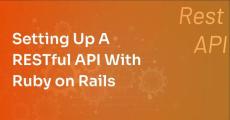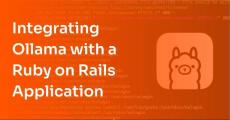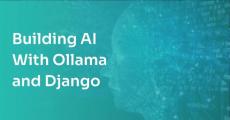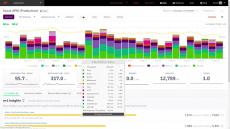|
By Scout APM
Ruby on Rails is an excellent choice for building a REST API, stemming from its design principles and robust feature set. It encourages a resource-oriented architecture, including built-in routing, migrations, and task tools. Rails also includes Active Record, an Object-Relational Mapping (ORM) layer, which simplifies database interactions.
|
By Scout APM
Imagine you're building an e-commerce application. You want to use Django and bring all the benefits of that framework. But there are issues. Django's service-oriented architecture doesn’t play well with the event-driven nature of what you need to build. You need to automatically send a welcome email when a new user registers, instantly update inventory levels when an item is purchased, and notify users when their orders are shipped.
|
By Sarah Morgan
Let’s start with a statement everyone can agree on: AI coding is now a permanent fixture of the software development lifecycle. Even if your team hasn’t introduced it officially yet, it’s only a matter of time before one of your peers kicks off the discussion or pushes a PR that, perhaps even unbeknownst to you, is entirely AI-generated. Now, let’s rub some folks the wrong way: AI coding in a microservices architecture is a recipe for disaster.
|
By Scout APM
Check out Scout Monitoring's ollama-rails GitHub repo for samples on how to use ollama-ai to communicate with Ollama. Large Language Models (LLMs) have emerged as a game-changer, enabling machines to understand, generate, and process human language with unprecedented accuracy and fluency. One such tool that has gained significant attention is Ollama, a cutting-edge platform that allows developers to run LLMs locally without relying on cloud services.
|
By Scout APM
If you’re not building with AI, are you even building these days? Sometimes, it seems not. AI has become such an integral part of workflows throughout many tools that a clear understanding of integrating it into your product and framework is critical. Django is such a framework that powers thousands of products across the web: Instagram, Pinterest, and Mozilla are all services built on Django.
|
By Scout APM
Background job processing is integral to modern software architecture. Background jobs allow resource-intensive tasks to be handled asynchronously, improving your application’s responsiveness and efficiency. You can use background processing for tasks such as sending emails, data processing, and batch jobs. If you were to run these synchronously, they could significantly degrade the user experience and system performance. Thus, most frameworks have libraries for running background jobs.
|
By Hayley Keith
After Twitter moved from Ruby to Scala in 2009, the story was born that Ruby on Rails can’t scale. The story goes that it lacks robustness, is a memory hog, and lacks the concurrency features you need to grow an application. This has been the prevailing wisdom for over a decade. And then along came Shopify, showing that, as Lutke says, Ruby on Rails is a framework that can process billions of events per day and evidently does scale. Ruby on Rails is an excellent candidate for scaling.
|
By Scout APM
Django is one of the leading Python frameworks used to create full-stack web applications. In this comprehensive guide, you will explore the intricacies of testing and debugging within the Django framework, focusing on advanced methodologies and essential tools. Beginning with the fundamentals of Django unit and integration testing, you will delve into advanced techniques such as mocking, testing middleware, and profiling for optimal performance.
|
By Scout APM
Django is a “batteries-included” framework. It has a wide array of built-in features that handle common web development tasks: URL routing, template engine, object-relational mapping (ORM), and database schema migrations. This makes it highly efficient for rapid development, allowing developers to focus on building their applications' unique aspects without reinventing basic functionalities.
|
By Sarah Morgan
This is the third in a series. Read Part 1 and Part 2. “2001: A Space Odyssey” doesn’t spend time on the training contexts of its antagonist, HAL 9000. The only clues we get are upon its “death,” where it regresses back to its earliest lessons, like singing “Daisy Bell” as it winds down for the last time, suggesting it started with the very basics and grew more complex only with time and practice.
|
By Scout
3 Key Benefits of switching to ScoutAPM over New Relic n+1 queries, Memory Bloat tabs show you easy performance enhancements.
- August 2024 (1)
- July 2024 (3)
- June 2024 (3)
- May 2024 (2)
- April 2024 (1)
- March 2024 (1)
- October 2023 (1)
- September 2023 (1)
- August 2023 (1)
- July 2023 (1)
- May 2023 (1)
- April 2023 (1)
- February 2023 (1)
- November 2022 (2)
- September 2022 (2)
- August 2022 (2)
- June 2022 (1)
- May 2022 (2)
- April 2022 (4)
- February 2022 (2)
- January 2022 (2)
- December 2021 (3)
- November 2021 (2)
- October 2021 (4)
- September 2021 (4)
- August 2021 (2)
- July 2021 (3)
- June 2021 (3)
- May 2021 (4)
- March 2021 (2)
- February 2021 (3)
- January 2021 (4)
- December 2020 (2)
- November 2020 (3)
- October 2020 (7)
- September 2020 (6)
- August 2020 (3)
- July 2020 (3)
- June 2020 (3)
- May 2020 (4)
- April 2020 (5)
- March 2020 (4)
- February 2020 (2)
Monitoring for the modern development team.
No developer ever said "I hope I get to spend all day hunting down a performance issue". When the unavoidable happens, The Scout platform is focused on finding the root cause of performance problems as quickly as possible.
Scout is monitoring for fast-moving dev teams like us. We leverage the tools that help us get big things done - Github, PaaS services, dynamic languages, frequent releases - to build a tailored monitoring platform for modern teams.
Scout continually tracks down N+1 database queries, sources of memory bloat, performance abnormalities, and more.
Get back to coding with Scout.












